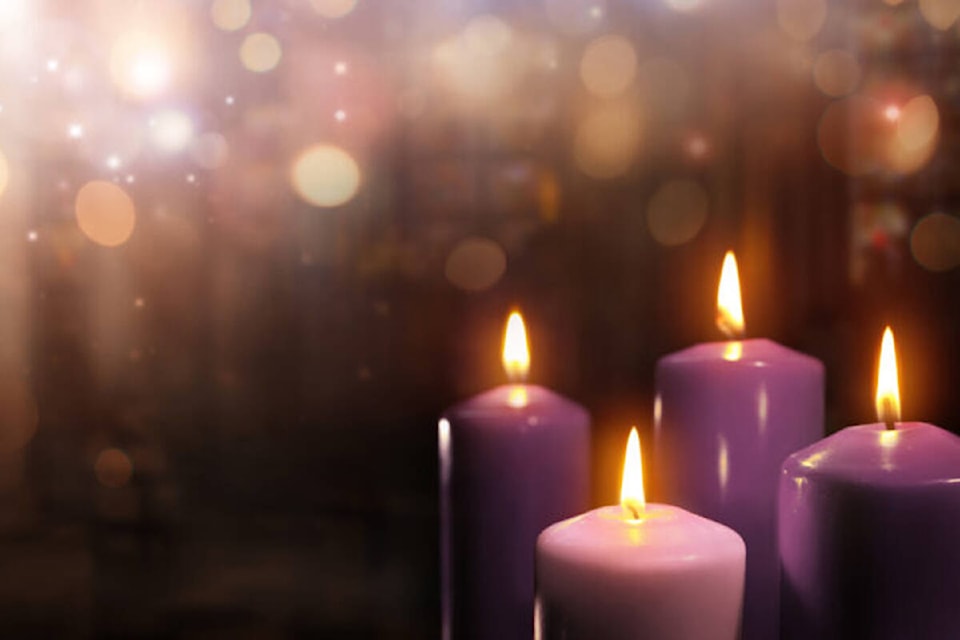We are just over halfway through the season of Advent. Advent is a difficult season to celebrate. All around us, people and retailers and advertisers and marketers are already celebrating Christmas, and in these short days of December, Christmas carols play in an endless loop.
How do we mark a season of preparation, anticipation, and hope while everyone else is already celebrating? Somebody noted recently that we should be talking about a “war on Advent” instead of a “war on Christmas.”
“Advent” comes from the Latin word adventus, which means “coming.” We prepare to celebrate the arrival, the birth, of the one whom Christians name “the Light of the world.”
That’s why one of the practices of Advent is to light candles. Many churches set up an Advent wreath. A ring of greenery, a symbol of life, contains five candles. The candles used to be purple, since the early church thought of Advent as a season of penitence and introspection, much like Lent. Purple is the colour of repentance.
However, as we reflected on the church calendar, the tone of Advent changed to a celebration of hope and anticipation. Churches began using blue candles. In the centre of the ring, a white candle waits to be lit on Christmas Eve.
Each week, we light one more candle. Some churches name the candles — the Candles of Hope, Peace, Joy, and Love. The fifth candle is the Christ Candle. Others name the candles as the Prophecy candle, the Bethlehem candle, the Shepherds’ candle, the Angels’ candle, and the Purity candle.
It’s fine to do that. After all, hope, peace, joy, and love are worthy subjects for us to reflect on.
But when we do that, we diminish the power of the symbolism of the candles. They don’t “stand for” something. Rather, the candles participate in the primal symbol of light. We’ve lost the power of this primal symbol in a world where we can turn on the LED lights with the flick of a switch.
With these candles, the light grows week by week. We start in darkness on the First Sunday of Advent, the first day of a new year for the church, and we light a single flickering candle. It is a fragile light; it can be snuffed with a single puff, so we guard the light. We care for this frail light, shielding it to hold the darkness at bay as we prepare in hope. Week by week, the light grows until the world is ablaze when Christmas finally comes.
Entering the darkness and shining light is an important part of our Advent celebration. We enter the shadows of despair, war, sorrow, and hate. We wait actively for Jesus to come. We light candles and our hope grows with the light. We embody that hope as we live peacefully, joyfully, lovingly. We wait. We sing. We pray anew for light–in–the–midst–of–shadows.
That sense of hope is challenged as we move into those places where all hope seems lost — the desperate refugee family; the isolated prisoner; the heartbroken addict; the shivering homeless person; the widow/widower who struggles to make it through this season; the first responder traumatized by PTSD; the spouse caring for a lifetime partner who is slipping into dementia; the hospital worker who is running on fumes as the pandemic endures, and she ends up treating people who refuse to be vaccinated; the family which works multiple jobs for shelter and food.
We enter the shadows carrying the fragile light within us. We proclaim a hope that rings out in the midst of catastrophe. In the gloom of this time, we point to the light which is just barely visible. We seek signs of hope that one is coming whose name is Peace, whose name is Light, whose name is Hope.
We are not just waiting around in Advent. Rather, we are keeping watch, ready to act in hope and compassion. The anticipation of Advent is dynamic.
The 12th century abbot and theologian Bernard of Clairvaux write eloquently about “three Advents”.
The first Advent was the birth, the Incarnation, the Advent at Christmastide. We tell the story of an unwed teenaged Palestinian peasant woman bearing a child, giving birth in the place where animals lay, in the midst of poverty. In Matthew’s story, that young family became refugees, rushing to Egypt in fear of their lives as the murderous King Herod sought to put this child to death.
The third Advent was the Advent at the end of the age, the Parousia when Jesus would come again to set everything right. It would herald the true coming of God’s kingdom, for which we pray every time we utter the Lord’s Prayer— “your kingdom come on earth as in heaven.”
The second Advent is the one in between, the everyday arrival of Jesus: the knock at the door; the still, small voice; the hungry mother seeking food for herself and her children; the migrant worker; the weary refugee; the asylum seeker; the tired, cold, homeless person begging for a word of comfort, a dollar of hope. Leo Tolstoy tells the story of this Advent beautifully in “Where Love Is, God Is,” also known as “Martin the Cobbler.”
In my mind this second Advent is most important of all. We learn to discern where Jesus comes again and again. The growing, flickering light amid the shadows of the world grows within us and around us. Our hope spurs us to action as we seek where we may find the Christ child in our world as we hear of wars and rumours of wars.
In this second Advent, we discern anew that faith is a verb. Our faith is the way in which we also incarnate God’s love, God’s justice, God’s peace, God’s intention for our world.
Yme Woensdregt is a retired Anglican priest living in Cranbrook
